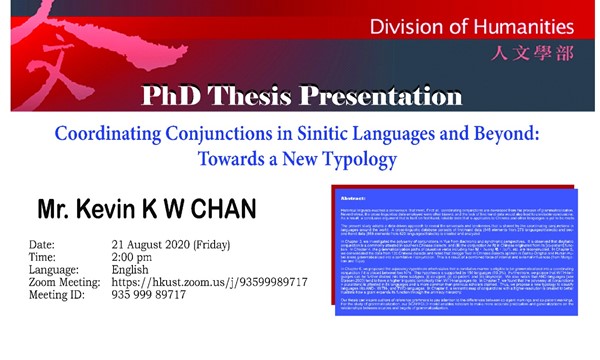Abstract:
Historical linguists reached a consensus that most, if not all, coordinating conjunctions are developed from the process of grammaticalization. Nevertheless, the cross-linguistics data employed were often biased, and the lack of first-hand data would also lead to unreliable conclusions. As a result, a conclusive argument that is built on first-hand, reliable data that is applicable to Chinese and other languages is yet to be made.
The present study adopts a data-driven approach to reveal the universals and tendencies that is shared by the coordinating conjunctions in languages around the world. A cross-linguistic database consists of first-hand data (645 elements from 278 languages/dialects) and second-hand data (888 elements from 829 languages/dialects) is created and analyzed.
In Chapter 3, we investigated the polysemy of conjunctions in Yue from diachronic and synchronic perspectives. It is observed that disyllabic conjunction is a commonly attested in southern Chinese dialects; and (iii) the conjunction he 和 in Chinese originated from its [co-patient] function. In Chapter 4, the grammaticalization paths of causative verbs including han 喊, huang 喚, /ɛu55/, etc. are reconstructed. In Chapter 5, we consolidated the data from 125 Chinese dialects and noted that liangge ‘two’ in Chinese dialects spoken in Gansu-Qinghai and Hunan-Hubei areas grammaticalized into a comitative / conjunction. This is a result of a combined force of internal and external influences (from Mongolian and Tujia).
In Chapter 6, we proposed the adjacency hypothesis which states that a comitative marker is eligible to be grammaticalized into a coordinating conjunction if it is placed between two NPs. This hypothesis is supported by 150 languages (99.3%). Furthermore, we propose that WITH-languages can be further divided into three subtypes, (i) co-agent, (ii) co-patient, and (iii) bisyndetic. We also notice that AND-languages (see Stassen 2000) tend to have a higher linguistic complexity than WITH-languages do. In Chapter 7, we found that the polysemy of [conjunctions = pluralizers] is attested in 84 languages and is more common than previous scholars claimed. Thus, we propose a new typology to classify languages into AND-, WITH-, and TWO-languages. In Chapter 8, a semantic map of conjunctions with a higher-resolution is created to better illustrate how a gram expands its function through the animacy hierarchy.
Our thesis can inspire authors of reference grammars to pay attention to the differences between co-agent markings and co-patient markings. For the study of grammaticalization, our SCAFFOLD model enables scholars to make more accurate predication and generalizations on the relationships between sources and targets of grammaticalization.
https://engage.ust.hk/event/6173324
huma@ust.hk
